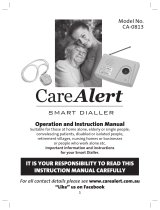Page is loading ...

Wrist Alarm
Stylish Wrist Alarm
Product Code: AL00009
Introduction
The unique watch style design is unobtrusive to wear making it great for those that find clip on or key ring
alarms unsuitable. The wrist alarm has a powerful 130dBs siren to shock attackers. The alarm has a highly
durable ‘one size fits all’ Velcro strap which is easy to fit.
Operation of the alarm
1. To operate the alarm, simply push the button on the face of the alarm.
2. To stop the alarm sounding, push the button on the underside of the alarm.
Battery replacement
It is recommended that the alarm is tested regularly. If the alarm sounds weak, the batteries should be
replaced. To replace the batteries, tear the Velcro apart (see image below) and remove the two spring
loaded pins. To remove the pins, pull the pin between the threads and the hole where the pin fits. The pin
will spring out. This gives you access to the back cover. Remove the four screws from the back cover and
replace the batteries noting the correct polarity. The unit operates by 2 x LR44 (or equivalent) button
batteries. Then put the screws and the pins back in place.
WARNING
The high output siren fitted to this quality personal alarm may cause ear damage if used at close range for
a prolonged period of time. Keep away from children and pets ears. This product is designed for use as a
deterrent; it does not guarantee protection or personal safety.
Tear the Velcro
apart
Remove the 2 spring
loaded pins to gain
access to the back cover
Negative Pole (-)
Positive Pole (+)
Remove the screws to
replace batteries

CAUTION
When testing the alarm, make sure you hold it at least at arm’s length away from your ear
The power source or propellant has a finite / limited life
DO NOT MODIFY THE ALARM.
The alarm should be kept out of reach and audible range of children and pets
Note: Performance may be adversely affected following prolonged exposure to extreme temperatures.
Personal Safety Alarm Guidance
It is advised that use of an audible personal alarm should not be relied on as the sole means of preventing
an attack and should be used in conjunction with other precautionary measures. Please note the following
advice:
General use
Always have the alarm close to hand and ready for use
Plan your route / journey in advance
Tell someone where you are going and what time you will be back
Walk with confidence
Be alert
When in your car
Always have the alarm close to hand and ready for use
Always park in well lit areas
Have the keys ready as you approach your car
If another vehicle (including the police) is signalling you to stop, do not pull over in an isolated
spot, wait until you reach a safe area
Be alert at all times
Before you use your alarm
Be sure you know how to activate and de-activate the alarm
Make regular checks on power and at the first indication of a weak sound, replace the battery
Practice appropriate means of carrying the alarm ready for use
Remember
Personal safety alarms are designed for use by individuals who are under threat from attack and should be used with care
and responsibility. It is intended to shock and disorientate an attacker to provide a distraction so that the user can make
an escape.
It is not intended to be used as a distress signal for attracting help and attention. However the noise may induce fear of
intervention and detection of others so this is an opportune secondary function.
DON’T FORGET AN AUDIBLE PERSONAL ALARM SHOULD NOT BE EXPECTED TO PROVIDE A COMPLETE SAFEGUARD
AGAINST ASSAULT AND USERS SHOULD ALWAYS TAKE SUITABLE PRECAUTIONS TO REDUCE THE RISK OF ATTA CK.
/

